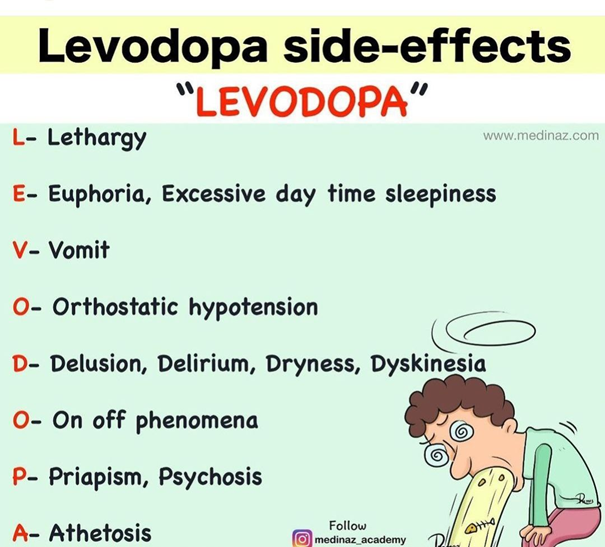Which adverse effects associated with levodopa therapy would support the nursing diagnosis Risk for Injury?
Orthostatic hypotension
Nausea and vomiting
Anorexia and depression
Tachycardia and palpitations
The Correct Answer is A
A. Orthostatic hypotension:
Orthostatic hypotension, a sudden drop in blood pressure when standing up, is a potential adverse effect of levodopa therapy. This can lead to dizziness and increase the risk of falls, thus supporting the nursing diagnosis Risk for Injury.
B. Nausea and vomiting:
Nausea and vomiting are common side effects of levodopa therapy. While they can cause discomfort and dehydration, they are less directly related to the risk of physical injury compared to orthostatic hypotension.
C. Anorexia and depression:
Anorexia (loss of appetite) and depression can occur as adverse effects of levodopa therapy. While they can affect the patient's overall well-being and quality of life, they are not directly associated with an increased risk of physical injury.
D. Tachycardia and palpitations:
Tachycardia (rapid heart rate) and palpitations are less common adverse effects of levodopa therapy. While they may indicate cardiovascular issues, they are not typically associated with a direct risk of physical injury.

Nursing Test Bank
Naxlex Comprehensive Predictor Exams
Related Questions
Correct Answer is A
Explanation
A. The client should maintain systolic BP between 120 and 129 mm Hg.
This is an appropriate recommendation. The American Heart Association (AHA) guidelines recommend maintaining systolic BP below 130 mm Hg to reduce the risk of stroke and other cardiovascular events in individuals with a history of stroke or TIA.
B. The client should maintain systolic BP between 130 and 135 mm Hg.
This is slightly above the recommended range. While systolic BP below 135 mm Hg is generally recommended for individuals with a history of stroke or TIA, a range of 130-135 mm Hg may still be acceptable based on individual patient factors and risk assessments.
C. The client should maintain systolic BP between 136 and 140 mm Hg.
This is above the recommended range. Systolic BP between 136 and 140 mm Hg may be considered elevated and should be managed to lower levels to reduce the risk of recurrent TIA or stroke.
D. The client should maintain systolic BP between 141 and 145 mm Hg.
This is above the recommended range. Systolic BP above 140 mm Hg is generally considered elevated and should be managed to lower levels to reduce the risk of recurrent TIA or stroke.
Correct Answer is C
Explanation
A. Semicomatose:
This term suggests a state between consciousness and coma. A patient who is semicomatose may exhibit some level of responsiveness but is typically unresponsive or only responds to intense stimuli.
B. Somnolent:
Somnolence refers to a state of drowsiness or sleepiness. A somnolent patient may appear sleepy, have difficulty staying awake, and may be slow to respond to stimuli. However, the withdrawal from painful stimuli described in the scenario suggests a higher level of responsiveness than what would typically be expected in a somnolent state.
C. Lethargic:
Lethargy describes a state of reduced alertness or responsiveness. A lethargic patient may appear drowsy, sluggish, and have diminished responses to stimuli. The description of the patient as stuporous (having a decreased level of consciousness) but still reacting by withdrawing from painful stimuli aligns with the characteristics of lethargy.
D. Comatose:
Coma refers to a state of profound unconsciousness where the patient is unresponsive to all stimuli, including painful stimuli. A comatose patient does not demonstrate any purposeful movement or response to stimuli. Since the patient in the scenario exhibits some response to painful stimuli by withdrawing, they do not meet the criteria for being comatose.
Whether you are a student looking to ace your exams or a practicing nurse seeking to enhance your expertise , our nursing education contents will empower you with the confidence and competence to make a difference in the lives of patients and become a respected leader in the healthcare field.
Visit Naxlex, invest in your future and unlock endless possibilities with our unparalleled nursing education contents today
Report Wrong Answer on the Current Question
Do you disagree with the answer? If yes, what is your expected answer? Explain.
Kindly be descriptive with the issue you are facing.
